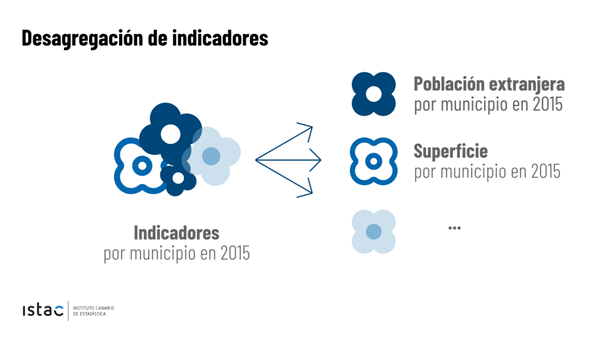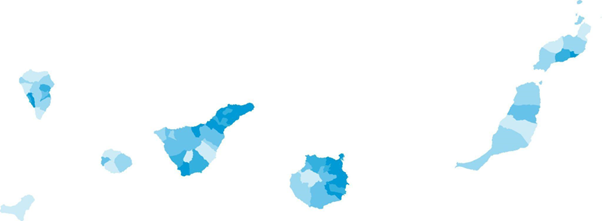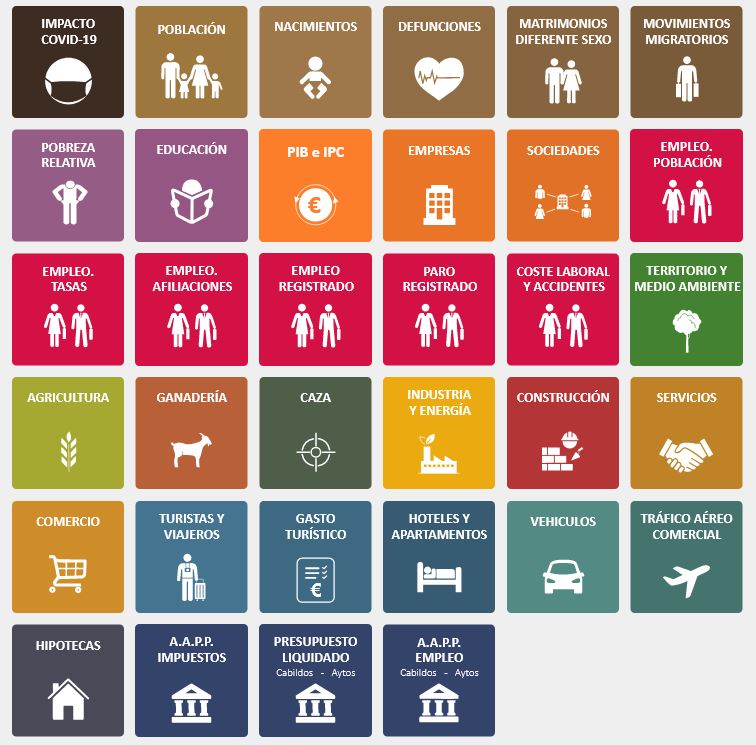At the end of 2023, as reported by datos.gob.es, the ISTAC made public more than 500 semantic assets, including 404 classifications or 100 concept schemes.
All these resources are available in the Open Data Catalog of the Canary Islands, an environment in which there is room for both semantic and statistical resources and which, therefore, may involve an extra difficulty for a user looking only for semantic assets.
To facilitate the reuse of these datasets with information so relevant to society, the Canary Islands Statistics Institute, with the collaboration of the Directorate General for the Digital Transformation of Public Services of the Canary Islands Government, published the Bank of Semantic Assets.
In this portal, the user can perform searches more easily by providing a keyword, identifier, name of the dataset or institution that prepares and maintains it.
The Bank of semantic assets of the Canary Islands Statistics Institute is an application that serves to explore the structural resources used by the ISTAC. In this way it is possible to reuse the semantic assets with which the ISTAC works, since it makes direct use of the eDatos APIs, the infrastructure that supports the Canary Islands statistics institute.
The number of resources to be consulted increases enormously with respect to the data available in the Catalog, since, on the one hand, it includes the DSD (Data Structures Definitions), with which the final data tables are built; and, on the other hand, because it includes not only the schemes and classifications, but also each of the codes, concepts and elements that compose them.
This tool is the equivalent of the aforementioned Fusion Metadata Registry used by SDMX, Eurostat or the United Nations; but with a much more practical and accessible approach without losing advanced functionalities. SDMX is the data and metadata sharing standard on which the aforementioned organizations are based. The use of this standard in applications such as ISTAC's makes it possible to homogenize in a simple way all the resources associated with the statistical data to be published.
The publication of data under the SDMX standard is a more laborious process, as it requires the generation of not only the data but also the publication keys, but in the long run it allows the creation of templates or statistical operations that can be compared with data from another country or region.
The application recently launched by the ISTAC allows you to navigate through all the structural resources of the ISTAC, including families of classifications or concepts, in an interconnected way, so it operates as a network.
Functionalities of the Semantic Asset Bank
The main advantage of this new tool over the aforementioned registries is its ease of use. Which, in this case, is directly measured by how easy it is to find a specific resource.
Thanks to the advanced search, specific resources can be filtered by ID, name, description and maintainer; to which is added the option of including only the results of interest, discriminating both by version and by whether they are recommended by the ISTAC or not.
In addition, it is designed to be a large interconnected bank, so that, entering a concept, classifications are recommended, or that in a DSD all the representations of the dimensions and attributes are linked.
These features not only differentiate the Semantic Asset Bank from other similar tools, but also represent a step forward in terms of interoperability and transparency by not only offering semantic resources but also their relationships with each other.
The new ISTAC resource complies with the provisions both at national level with the National Interoperability Scheme (Article 10, semantic assets), and at European level with the European Interoperability Framework (Article 3.4, semantic interoperability). Both documents defend the need and value of using common resources for the exchange of information, a maxim that is being implemented transversally in the Government of the Canary Islands.
Training Pill
To disseminate this new search engine for semantic assets, the ISTAC has published a short video explaining the Bank and its features, as well as providing the necessary information about SDMX. In this video it is possible to know, in a simple way and in just a few minutes how to use and get the most out of the new Semantic Assets Bank of the ISTAC through simple and complex searches and how to organize the data to respond to a previous analysis.
In summary, with the Semantic Asset Bank, the Canary Islands Statistics Institute has taken a significant step towards facilitating the reuse of its semantic assets. This tool, which brings together tens of thousands of structural resources, allows easy access to an interconnected network that complies with national and European interoperability standards.
The Canary Islands Statistics Institute (ISTAC) has taken a significant step forward in the volume of geographic data thanks to the publication of a total of 4,002 new datasets (3,859 thematic maps and 143 statistical cubes) in datos.gob.es, following its federation in Canarias Datos Abiertos.
This type of initiative is aligned with the European Union's Data Strategy, which establishes the guidelines to achieve a single data market that benefits companies, researchers and public administrations. The automation of publication processes through common standards is key to ensure interoperability and adequate access to open data sets of public administrations.
The generation of these datasets is the culmination of an automation work that has allowed the expansion of the number of published cubes, as now combinations of granularity and year since 2004 are presented. In early October, the ISTAC added to its catalog more than 500 semantic assets and more than 2100 statistical cubes, as we told in this post on datos.gob.es.
In addition, the sets published to date have undergone a renewal process to become the aforementioned 143 statistical cubes. The increase of these datasets not only improves the directory of datos.canarias.es and datos.gob.es in quantitative terms, but also broadens the uses it offers thanks to the type of information added.
The indicators of these cubes are represented on the cartography through choropleth maps and in multiple formats. This automation will, in turn, not only allow other datasets to be published more easily in the future, but also more frequently.
Another of the advances of this work is that the services are generated on the fly from the Geoserver map server, and not through an upload to CKAN, as was done until now, which reduces their storage and speeds up their updating.
How to bring demographic indicators closer to the population
Demographic indicators are dense data cubes that offer a large amount of detailed geographic information, including total population, disaggregated by sex, residence, age and other indices up to a total of 27 different variables.
As so much information is contained in each cube, it can be difficult to represent specific indicators on the cartography, especially if the user is not used to working with certain GIS (Geographical Information System) software.
To bring this content to all types of users, the ISTAC has generated 3,859 new maps, representing on a choropleth map each of the indicators contained in the 143 statistical cubes. The publication of these new cartographic data is thus presented as a more efficient and simplified way of obtaining the information already represented, allowing users to easily access the specific data they need.
We could compare this transformation to flowers. Previously, only whole bouquets were published, with 27 flowers per bouquet, which had to be managed and handled to represent the flowers that were of interest. Now, in addition to continuing to publish the bouquets, new processes have been generated to be able to publish each flower separately, automating the generation of each of these sets, which will also be updated more frequently.

This new option facilitates the use of these choropleth maps (like the one shown in the image) by people without technical GIS knowledge, since they are presented in easily downloadable formats as images (.jpg and .png) for professional, educational or personal use.


Mapa de población de 65 o más años (% sobre total) por municipios. Año 2022
For more advanced users, ISTAC has also expanded the range of formats in which the original indicator cubes are served. The "bouquets", which previously only showed data in CSV format, now have a wide variety of distributions: KML, GML, GeoPackage, GeoJSON, WFS, WMS. Taking advantage of the benefits provided by the use of styles in the WMS format, all the styles associated with the indicators have been generated, so that, using them, it is possible to represent the same map that is downloaded in image format. These styles are calculated for each indicator-granularity-year combination, according to the method of calculating quantiles for five intervals.
This new approach with both simple and complex geographic data enriches the catalog and allows users without specific knowledge to access and reuse them. In addition, it should be noted that this opens the door to other massive publications of data based on other statistical operations.
In short, this is an important step in the process of opening up data. A process that improves the use and sharing of data, both for the user on the ground and for professionals in the sector. Given the growing need to share, process and compare data, it is essential to implement processes that facilitate interoperability and appropriate access to open data. In this sense, the Canary Islands Institute of Statistics is concentrating its efforts to ensure that its open data sets are accessible and in the appropriate formats for sharing. All this in order to obtain value from them.
Local statistical data helps us better understand our environment and identify variations between regions. This is essential to be able to formulate local policies tailored to the specific needs of the local population, something that has even been highlighted by the UN in one of its reports. In this sense, in the datos.gob.es catalog you can find statistical information on different localities and regions, such as the population and housing census, administrative records or even economic indicators.
One of the latest additions to our catalog is the Canary Islands Statistics Institute (Istac), as part of the datos.canarias.es initiative. The institute is the new Canary Islands Open Data Portal that is positioned as the only point of access to open data on the island in collaboration with the rest of the regional public administrations.
At the end of January, datos.canarias.es federated with datos.gob.es, incorporating 7,460 new datasets from the Istac and other organizations on the Island.
What kinds of data sets are available?
The federated data are categorized according to the recommendations of the Application Guide of the Technical Standard for Interoperability for the Reuse of Information Resources and address a wide range of topics related to the territory, the environment, demographics, the economy, and living conditions or the public sector. Shared data is divided into the following categories:

Istac's commitment to open data
The Decree approving the Statistical Plan of the Canary Islands 2018-2022 (PEC-22), establishes that during its execution the reuse of statistical data will be promoted in accordance with the Law on reuse of public sector information. At the same time, it indicates that the Statistical Data and Metadata Infrastructure (eDatos) will be the support for the open and interoperable dissemination of the data published by the statistical activities of the PEC-22, becoming the only channel for the decentralized dissemination of statistics in the corporate websites of the Government of the Canary Islands.
To comply with the aforementioned guidelines, the Istac has made the open data portal of public statistics in the Canary Islands available to the public, which, under the principles of public statistics and data reuse, distributes the data generated in a manner free, in open formats and with licenses that allow its reuse for commercial and non-commercial purposes.
The portal integrates data and metadata based on standardized semantic assets, geographic information and services to promote their use; and it has programmable application interfaces (API) that facilitate the access and download of the information by third parties. In addition to these APIs, it also provides a series of query tools that allow both downloading the data (for example an Extension for QGIS or an R Package), and taking it to another web or application, such as Widgets, Tableau Public or Google Public Data Explorer.
The website also has a statistical indicator viewer. The user can select the information they want to view from a large number of categories, for example, births and deaths, or the workforce. You can also choose the geographic space (the community as a whole or any specific island or municipality), the type of data (annual, interperiodic variation, etc.) and the temporal range. With this information, the tool will generate the graph with the Istac data.
All these tools show the interest of the Istac and the Government of the Canary Islands not only to facilitate access to their data, but also to promote its reuse by developers who want to create value-added products. With its integration in datos.canarias.es, the visibility of the local statistical data of the Canary Islands is promoted, at the same time that access to the data of interest of the entire Autonomous Community is homogenized.